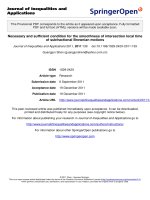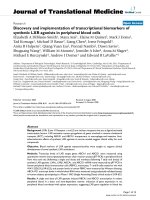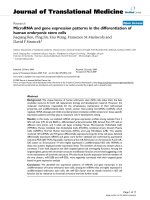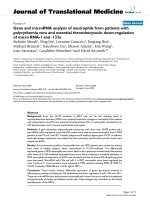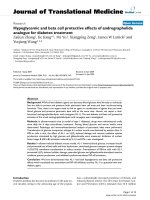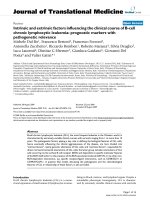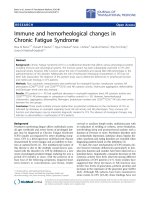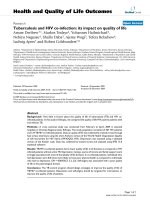báo cáo hóa học: " Tuberculosis and HIV co-infection: its impact on quality of life" potx
Bạn đang xem bản rút gọn của tài liệu. Xem và tải ngay bản đầy đủ của tài liệu tại đây (206.99 KB, 7 trang )
BioMed Central
Page 1 of 7
(page number not for citation purposes)
Health and Quality of Life Outcomes
Open Access
Research
Tuberculosis and HIV co-infection: its impact on quality of life
Amare Deribew*
1
, Markos Tesfaye
2
, Yohannes Hailmichael
3
,
Nebiyu Negussu
4
, Shallo Daba
5
, Ajeme Wogi
5
, Tefera Belachew
6
,
Ludwig Apers
7
and Robert Colebunders
7,8
Address:
1
Department of Epidemiology, Jimma University, Jimma, Ethiopia,
2
Department of Psychiatry, Jimma University, Jimma, Ethiopia,
3
Department of Health Service Management, Jimma University, Jimma, Ethiopia,
4
Malaria Control Program, Somali regional Health Bureau, Jijiga,
Ethiopia,
5
HIV Prevention and Control office, Oromiya Regional Health Bureau, Addis Ababa, Ethiopia,
6
Department of Population and Family
Health, Jimma University, Jimma, Ethiopia,
7
Department of Clinical Sciences, Institute of Tropical Medicine, Nationalestraat 155, 2000 Antwerp,
Belgium and
8
Department of Epidemiology and Social Medicine, University of Antwerp, Campus Drie Eiken, Universiteitsplein 1 2610 Antwerpen,
Belgium
Email: Amare Deribew* - ; Markos Tesfaye - ;
Yohannes Hailmichael - ; Nebiyu Negussu - ;
Shallo Daba - ; Ajeme Wogi - ; Tefera Belachew - ;
Ludwig Apers - ; Robert Colebunders -
* Corresponding author
Abstract
Background-: Very little is known about the quality of life of tuberculosis (TB) and HIV co-
infected patients. In this study in Ethiopia, we compared the quality of life HIV positive patients with
and without TB.
Methods-: A cross sectional study was conducted from February to April, 2009 in selected
hospitals in Oromiya Regional state, Ethiopia. The study population consisted of 467 HIV patients
and 124 TB/HIV co-infected patients. Data on quality of life was collected by trained nurses through
face to face interviews using the short Amharic version of the World Health Organization Quality
of Life Instrument for HIV clients (WHOQOL HIV). Depression was assessed using a validated
version of the Kessler scale. Data was collected by trained nurses and analyzed using SPSS 15.0
statistical software.
Results: TB/HIV co-infected patients had a lower quality of life in all domains as compared to HIV
infected patients without active TB. Depression, having a source of income and family support were
strongly associated with most of the Quality of life domains. In co-infected patients, individuals who
had depression were 8.8 times more likely to have poor physical health as compared to individuals
who had no depression, OR = 8.8(95%CI: 3.2, 23). Self-stigma was associated with a poor quality
of life in the psychological domain.
Conclusion-: The TB control program should design strategies to improve the quality of life of
TB/HIV co-infected patients. Depression and self-stigma should be targeted for intervention to
improve the quality of life of patients.
Published: 29 December 2009
Health and Quality of Life Outcomes 2009, 7:105 doi:10.1186/1477-7525-7-105
Received: 16 September 2009
Accepted: 29 December 2009
This article is available from: />© 2009 Deribew et al; licensee BioMed Central Ltd.
This is an Open Access article distributed under the terms of the Creative Commons Attribution License ( />),
which permits unrestricted use, distribution, and reproduction in any medium, provided the original work is properly cited.
Health and Quality of Life Outcomes 2009, 7:105 />Page 2 of 7
(page number not for citation purposes)
Background
Ethiopia is among the countries most heavily affected by
the Human immunodeficiency Virus (HIV) and tubercu-
losis (TB). There are an estimated 1.3 million people liv-
ing with the virus and roughly 68,136 of them were
children under 15 years [1]. The World Health Organiza-
tion (WHO) has classified Ethiopia 7
th
among the 22 high
burden countries with TB and HIV infection in the world
[2]. The annual TB incidence of Ethiopia is estimated to be
341/100,000. TB mortality rate is 73/100,000 and the
prevalence of all forms TB is estimated to be 546/100,000
[3]. About 40-70% of HIV patients in Ethiopia are co-
infected with TB [4,5].
TB and HIV co-infection are associated with special diag-
nostic and therapeutic challenges and constitute an
immense burden on healthcare systems of heavily
infected countries like Ethiopia [1,2]. In Ethiopia, free
Antiretroviral therapy (ART) has been given to patients
since 2003[6]. Directly observed therapy short course
therapy (DOTS) for TB patients has been operational
since 1993 in Ethiopia [7]. To improve quality of life
(QOL), it is crucial to identify the determinants QOL.
Worldwide, many QOL studies have been performed
among patients with HIV infection [8-13] and among
patients with TB [14-18]. However, there is dearth of liter-
ature on the QOL of TB/HIV co-infected patients. In this
study in Ethiopia, we compare the QOL of HIV infected
patients with and without active TB.
Methods
Study Settings and Population
From February to April, 2009, we conducted a cross sec-
tional study in three hospitals in Oromiya regional state
of Ethiopia. Based on the availability of patients, we
selected Adama, Nekemet and Jimma specialized hospi-
tals in the east, west and southwest part of Ethiopia
respectively. The study population consisted of HIV
patients with and without active TB who had regular fol-
low up in the TB/HIV clinics of these hospitals for the last
one year. Sample size for the two groups was determined
using WINPEPI (Window program for Epidemiologist)
[19]. In a recent study, the mean score of general QOL
among HIV infected patients who were taking highly
active antiretroviral therapy in Jimma hospital was 87
[20]. Due to absence of data, we assumed HIV/TB co-
infected patients would have a 5% lower mean score of
general health as compared to HIV patients. With a power
of 80%, 95% CI, a 1:3 ratio of HIV/TB co-infected patients
versus HIV patients, and a 10% for non-response rate, the
sample size was 620 (155 co-infected patients and 465
HIV patients). During the study period, all new TB
patients were indentified among the HIV clients who reg-
ularly attended the HIV clinics. Only patients who were in
the intensive phase of anti-TB treatment during the study
period were included. For each TB/HIV co-infected
patients, 3 HIV patients without active TB were selected in
the TB/HIV clinics using a simple random sampling tech-
nique. The exclusion criteria for both groups were age less
than 15 years, the presence of an opportunistic infection
or a known chronic illness like diabetes mellitus and
hypertension. The sample size in each study group and
study setting is described below (Table 1).
Measurements
The KHB (Shanghi Kehua Bio-engineering, Ltd, 2008,
China) HIV test was used to diagnose HIV. For positive
results, confirmation was done using the STAT-PAK test
(Chembio diagnostic System Inc, 2008, USA). Smear
microscopy was the major diagnostic tool for pulmonary
TB. Patients who had two smear positive results were
labeled as smear positive. Patients who had three negative
smears and suggestive X-ray findings or failure to respond
to an antibiotic trials were labeled as smear negative pul-
monary TB. TB lymphadenitis was diagnosed based on
clinical parameters and cytological examination obtained
by fine needle aspiration. Data on QOL was collected by
trained nurses through face to face interview using the
short Amharic version of the World Health Organization
Quality of Life Instrument for HIV clients (WHOQOL
HIV) [8]. This instrument was used previously in Ethiopia
[21] and contains 31 items. For each item there is a five-
point Likert scale where 1 indicates low or negative per-
ceptions and 5 high or positive perceptions. These items
contain six domains: Physical health (4 items); psycho-
logical well being (5 items); social relationship (4 items);
environmental health (8 items); level of independence (4
items) and spiritual health (4 items). There were two gen-
eral questions about general QOL and perceived general
health. The physical domain contained information
Table 1: Selection of the study participants in three hospitals in the Oromiya regional state of Ethiopia April, 2009
Hospital Number on Antiretroviral therapy Randomly selected HIV patients Number of TB/HIV co-infected
Adama 4616 304 101
Jimma 1252 82 27
Nekemet 1185 78 26
Total 7053 465 155
Health and Quality of Life Outcomes 2009, 7:105 />Page 3 of 7
(page number not for citation purposes)
regarding presence of pain, energy and sleep. The psycho-
logical domain consisted of negative and positive feelings,
self esteem and thinking. The social domain covered
social support, personal relationships and sexual activity.
Mobility, work capacity, and activities were included in
the level of dependence. Financial issues; home and phys-
ical environment; availability of transport; physical safety
and security, and participation in leisure activities were
included under the environmental domain. The spiritual-
ity domain did contain questions about death and dying;
forgiveness and blame and concern about the future. We
also incorporated variables related to socio-demographic
factors, having source of income and family support into
the QOL instrument.
Depression was measured using the Kessler 10 scales [22].
This instrument has 10 questions each containing 5-point
Likert scales (1 = never, 2 = a small part of the time, 3 =
some of the time, 4 = most of the times, 5 = all of the
time). The Kessler-10 scale was validated in Ethiopia and
used extensively [23,24]. Perceived stigma was measured
by 23 questions adopted from Berger et al [25]. A detailed
description of the instrument is available elsewhere
[unpublished manuscript by the same authors]. The
stigma items consisted of four-point Likert scale (strongly
disagree, disagree, agree, strongly agree) questions. Ques-
tions were asked about perceived isolation, shame, guilt
and disclosure of the HIV status. Clinical information
such as CD4 lymphocyte count and WHO staging were
extracted from medical charts in the ART clinics.
Data Analysis
Data were analyzed using the SPSS version 15.0 software.
Domain scores in the WHOQOL-HIV were scaled in pos-
itive direction with higher score denoting good quality of
life. Negative questions like pain and discomfort were
recorded so that higher scores reflected better QOL. Mean
scores of items within each domain were used to calculate
the domain score. Mean scores were then multiplied by 4
in order to make domain scores comparable with the
scores used in the World Health Organization Quality of
Life instrument (WHOQOL-100). We used t-test and F-
test to compare means between groups. By taking the
mean or the median of each domain as a cutoff point,
QOL was dichotomized as poor or good. Mean was used
as a cutoff point for psychological, level of independence,
social, and environmental domains (because of a normal
distribution of the scores). Median was used as cutoff
point for physical and spiritual domains of QOL (because
of a skewed distribution of the scores). Individuals who
Table 2: Socio-demographic and clinical characteristics of the study population in three hospitals of the Oromiya region, Ethiopia.
Variables TB/HIV coinfected patients (N = 124)
Number (%)
HIV patients (N = 467)
Number (%)
P-Value
Age in Years
15-24 12(9.7) 42(9.0) 0.61
25-34 53(42.7) 223(47.8)
> = 35 59(47.6) 202(43.2)
Sex
Male 62(50) 185(39.6) 0.03
Female 62(50) 282(60.4)
Educational status
Illiterate 30(24.2) 74(15.8) 0.03
literate 94(75.8) 393(84.2)
Occupation
Government employee 17(13.7) 52(10.9) 0.003
Private employee 15(12.1) 84(18.0)
Merchant 1(8.1) 69(14.8)
Farmer 13(10.5) 32(6.9)
Housewives 15(12.1) 79(17.0)
Daily laborer 22(17.7) 93(20.0)
No Job 32(25.8) 58(12.4)
WHO staging 0.001
Stage II 13(10.6) 136(29.5)
Stage III 96(78%) 259(56.2)
Stage IV 14(11.4) 66(13.4)
CD4 lymphocyte count
<200 46(57.5) 112(27.3) 0.001
> = 200 34(42.5) 299(72.7)
On antiretroviral therapy 0.001
Yes 93(75.6) 464(100)
NO 30(24.4) 0
Health and Quality of Life Outcomes 2009, 7:105 />Page 4 of 7
(page number not for citation purposes)
scored below the mean/median were classified as having
poor QOL. To assess predictors of QOL (poor vs. good),
we first performed a bivariate analysis. Educational status,
occupation, WHO staging, having a source of income,
depression and perceived stigma did show statistically sig-
nificant association (P < 0.05) with QOL in the bivariate
analysis. These variables were entered into a stepwise
logistic regression model.
Ethical consideration
Ethical clearance was obtained from the Jimma University
ethical review board. Written informed consent was
obtained from the study participants. To ensure confiden-
tiality, we used codes to analyze the data.
Result
Characteristics of the study participants
Of the 620 patients asked to participate in the study, 591
(95%) accepted of whom 124 (21%) were TB/HIV co-
infected. Twenty nine participates refused to participate in
the study. Of the co-infected patients, 61(49.2%) were
smear negative, 42(33.8%) smear positive and 21(17%)
extrapulmonary TB patients.
Illiterates and males were more likely to have active TB
than their counter parts (P < 0.05). Co-infected patients
were more likely to have a lower CD4 lymphocyte count
than HIV patients (P = 0.001). All HIV patients and 75%
of the co-infected patients were taking ART during the sur-
vey (Table 2).
The Kessler Scale and the stigma instrument
The correlation between items in the Kessler scale ranged
from 0.5 to 0.79 with no multicollinearity and redun-
dancy. The internal consistency of the Kessler scale was
high (Cronbach's α = 0.93). Confirmatory factor analysis
showed that correlation between stigma items ranged
0.49 to 0.75. There was strong correlation between stigma
scales and depression (P < 0.05). Cronbach's alpha for the
stigma scales ranged from 0.71 to 0.88.
Internal consistency of the WHOQOL-HIV
To measure internal consistency, the Cronbach's alpha
was calculated for each domain of the instrument. Most
domains of the Amharic version of the WHOQOL-HIV
had a high value of Cronbach's alpha (α > 0.7). However,
social relationship had a lower internal consistency (α =
0.57) as compared to others (Table 3).
Inter domain correlations showed that there were statisti-
cally significant associations between domains. However,
a weak correlation was observed between the environ-
mental domain and spiritual health (Table 4).
We found strong correlation between the QOL domains
and the Kessler Scale. Strong correlation was observed
between the Psychological domain and the Kessler scale
(correlation coefficient, r = -0.59, P = 0.001). Physical,
level of independence, spiritual, social and environmental
domains had a correlation coefficient of -0.56, -0.54,-
0.45,-0.43 and -0.34 with the Kessler scale respectively (P-
value = 0.001). Stigma had also statistically significant
negative correlation with the spiritual (r = -0.45, P-value =
0.001), psychological (r = -0.33, P-value = 0.001) and
social (r = -0.26, P-value = 0.001) domains of QOL.
Quality of life
After controlling for potential confounding variables like
age, sex, occupation, CD4 lymphocyte count, WHO stag-
ing and social support, co-infected patients had a lower
mean/median score in all domains indicating poor QOL.
Mean scores for physical health, social relationship and
environmental health among co-infected patients were
Table 3: Internal consistency of the Amharic version of the WHOQOL-HIV questionnaire
Domain Coefficient for internal consistency (Cronbach's alpha)
Physical 0.77
Psychological 0.72
Social 0.57
Environmental 0.85
Level of independence 0.76
Spiritual 0.73
Table 4: Correlation between the domains of the Amharic
version of the WHOQOL-HIV questionnaire
Domain PH Psy Soc Env Ind Spir
PH 1
Psy 0.57 * 1
Soc 0.51 * 0.57 * 1
Env 0.48 * 0.33 * 0.48 * 1
Ind 0.76 * 0.52 * 0.50 * 0.55 * 1
Spir 0.46 * 0.56 * 0.39 * 0.21 * 0.35 * 1
* P < 0.01, PH = Physical health, Psy = psychological health, Soc =
Social relationship, Env = Environment, Ind = level of independence,
Spir = Spiritual health
Health and Quality of Life Outcomes 2009, 7:105 />Page 5 of 7
(page number not for citation purposes)
13.26(SD = 4.3), 12.15(SD = 3.1) and 11.7(SD = 3.6)
respectively (Table 5).
Predictors of QOL
Depression, having a source of income and family sup-
port were strongly associated with most of the QOL
domains. In co-infected patients, individuals with depres-
sion were 8.8 times more likely to have poor physical
health as compared to individual who had no depression,
OR = 8.8(95%CI: 3.2, 23). Similarly those without family
support were 1.5 more likely to have poor physical health
in co-infected and mono-infected patients (Table 6). Sim-
ilarly, depression, family support and having a source of
income were strongly associated with psychological
health (Table 7). Among co-infected patients, depressed
individuals were 5 times more likely to have poor social
relationships as compared to individual without depres-
sion, [OR = 5.3, (95%CI: 2.3, 14.2)]. Depression was also
associated with poor quality of the social QOL domain
among HIV patients OR = 2.4, (95%CI: 1.6, 3.6)]. Family
support was associated with social relationships in HIV
patients with and without co-infection (P < 0.001). Edu-
cational status was significantly associated with the envi-
ronmental QOL domain. Literate individuals were 4 times
more likely to have good QOL as compared to illiterate
ones, OR = 4, (95% CI: 2.3, 7.3). High perceived stigma
was associated with poor psychological health in TB/HIV
co-infected and HIV patients (P < 0.05).
Discussion
We compared the QOL of persons with HIV infection with
and without active TB. The Amharic version of the WHO-
QOL-HIV instrument had a good internal consistency to
assess the QOL of our TB/HIV co-infected patients. The
instrument had strong inter domain and negative correla-
tion with the Kessler scale and the stigma instrument.
Strong correlation between the Kessler scale and the psy-
chological domain of the QOL instrument indicated that
the two instruments had measured the same concept.
Although detail validity study was not done, the above
information could indicate that the Amharic Version of
the WHOQOL-HIV had good construct validity. The
WHOQOL-HIV instrument was previously reported to
have a good reliability and validity in different cultures
worldwide [26-28]. In this study, co-infected patients had
a lower QOL in all of the domains of the WHOQOL-HIV
as compared to people living with HIV without TB. The
occurrence of two stigmatizing diseases can decrease the
QOL by affecting the physical, social and mental wellbe-
ing of the person. In other studies, it was reported that
HIV patients had a lower QOL as compared to the general
population [13] and that TB patients had a lower QOL as
compared to their neighbors [17,18].
Different studies identified several factors which affect the
QOL of patients. In a multi-country study among patients
with HIV, it was found that women, older age groups, and
Table 6: Determinants of the physical health of HIV infected patients with and without TB in 3 hospitals of Oromiya region, Ethiopia
Physical health
Variables TB/HIV co-infection (n = 124) Adjusted OR(95%CI) HIV without TB (n = 476) Adjusted OR(95% CI)
Good
N (%)
Poor
N (%)
Good
N (%)
Poor
N (%)
Depression
Yes 7(36.8) 12(63.2) 8.8(3.2,23) 59(27) 159(73) 6.9(4.6,10.4)
No 22(51.2) 23(48.8) 1 181(72.6) 68(27.4) 1
Source of income
Yes
No 21(35)
8(14.8)
49(65)
46(85.2)
1
1.7(0.6,4.7)
188(54.8)
52(41.9)
155(45.2)
72(58.1)
1
1.7(1.1,2.6)
Family support
Yes 15(28.3) 38(71.7) 1 86(56.2) 67(43.8) 1
No 14(19.7) 57(81.3) 1.6(0.6,4) 159(49.8) 160(50.2) 1.5(1.0,2.3)
Table 5: Comparison of Quality of life of HIV infected patients with and without TB in 3 hospitals of the Oromiya region, Ethiopia
Quality of life Domain HIV TB co-infection (n = 124)
Mean(SD)
HIV without TB (n = 467)
Mean(SD)
P-Value
Physical Health 13.26(4.3) 16.81(2.8) 0.001
Psychological Health 14.99(3.2) 16.20(2.5) 0.001
Social relationship 12.15(3.6) 13.64(2.8) 0.001
Environmental Health 11.58(3.1) 12.41(2.7) 0.001
Level of independence 11.7(3.6) 14.98(2.8) 0.001
Spiritual health 16.46(3.9) 17.88(2.8) 0.001
Health and Quality of Life Outcomes 2009, 7:105 />Page 6 of 7
(page number not for citation purposes)
the less educated had a lower QOL [8]. A study conducted
among African American HIV positive participants
showed that stigma and presence of symptoms of HIV
were associated with poor QOL [9]. In our study, depres-
sion and lower income were associated with the physical,
social and environmental domains of QOL. Depression
can decrease QOL [29] but can also be the result of a poor
QOL. Because of the cross sectional nature of our study,
we couldn't establish a cause effect relationships between
QOL and depression. Perceived stigma was also associ-
ated with the psychological domain of QOL. The effect of
perceived stigma on QOL was also reported by Yen et al in
Taiwan [30].
Lack of social support, lower level of education and
income had been reported to be associated with poor
QOL of TB patients [15,18]. In our study, income, depres-
sion and lack of family support were predictors of poor
QOL among TB/HIV co-infected. Participants without
adequate income and family support might have a poor
nutritional and immune status which in turn could affect
the QOL.
In contrast with other studies, we couldn't find an associ-
ation between CD4 count, WHO staging and other socio-
demographic characteristics with QOL [8,15,18].
The results of our study have to be interpreted with cau-
tion. Indeed, although the Amharic version of the WHO-
QOL instrument was used previously, the content and
criterion validity of the instrument was not assessed.
Conclusion
TB/HIV co-infected patients had a poor QOL in all
domains of the WHOQOL-HIV instrument. Depression,
income and family support were strongly associated with
QOL. TB control programs should design strategies to
improve the QOL of TB/HIV patients. Depression and
self-stigma should be targeted for interventions to
improve the QOL. To maximize family support and QOL,
families of the patients should be counseled and edu-
cated.
Competing interests
The authors declare that they have no competing interests.
Authors' contributions
AD conceived the study and was involved in the design,
analysis and report writing. MT participated in the design
and reviewed the article. YH was involved in report writ-
ing and reviewing. NN was involved in report writing. SD
and AW were involved in field work and reviewed the arti-
cle. TB was involved in proposal development and report
writing. LA and RC participated in the design and critically
reviewed the article. All authors read and approved the
final manuscript.
Acknowledgements
The authors acknowledge the HIV prevention and control office of the
Oromiya regional health Bureau for funding the study. The authors appre-
ciate the study participants for their cooperation in providing the necessary
information.
References
1. Federal Democratic Republic of Ethiopia, Ministry of Health (FMOH),
HIV Prevention and Control Office: Single Point HIV Prevalence
Estimate. Addis Ababa, Ethiopia; 2007.
2. World Health Organization: Global Tuberculosis control: Sur-
veillance, planning and Financing. World Report 2008 [http://
www.who.int/tb/publications/global_report/en/].
3. World Health Organization: Global Tuberculosis Control: Sur-
veillance, Planning, Financing. WHO report 2007 [http://
www.who.int/tb/publications/global_report/2008/en/].
4. Afework K, Mengistu G, Ayele B: Coinfection and clinical mani-
festation of TB in HIV infected and uninfected adults at
teaching hospital, northwest Ethiopia. J Microbial Immunol Infect
2007, 40:116-112.
5. Demissie M, Lindtjon B, Tegbaru B: Human Immunodeficiency
virus (HIV) infection in tuberculosis patients in Addis Ababa.
Ethiop J Health Dev 2000, 14:277-282.
6. Federal Democratic Republic of Ethiopia, Ministry of Health (MOH):
National ART guideline. 2003 [ />].
7. Federal Democratic Republic of Ethiopia, Ministry of Health (MOH):
Tuberculosis and Leprosy prevention and control manual.
Addis Ababa, Ethiopia; 2005.
Table 7: Determinants of the Psychological health of HIV infected patients with and without TB in selected hospitals of Oromiya
Region, Ethiopia
Psychological health
Variables TB/HIV coinfection (n = 124) Adjusted OR(95%CI) HIV without TB (n = 467) Adjusted OR(95% CI)
Good
N (%)
Poor
N (%)
Good Poor
Depression
Yes 20(25.3) 59(74.7) 7.8(3.3,18.7) 85(38.9) 133(41.4) 6.1(3.9, 9.0)
No 32(71.1) 13(28.9) 1 197(79.1) 52(30.9) 1
Source of income
Yes 31(44.3) 39(55.7) 1 221(64.2) 123(35.8) 1
No 21(38.8) 33(61.2) 1.2(0.5, 2.8) 61(49.5) 62(50.5) 1.8(1.1,2.8)
Family support
Yes 28(52.8) 25(47.2) 1 101(66.0) 52(34.0) 1
No 24(33.8) 47(66.2) 2.7(1.1, 6.4) 181(57.6) 133(42.4) 1.5(1.0,2.3)
Publish with BioMed Central and every
scientist can read your work free of charge
"BioMed Central will be the most significant development for
disseminating the results of biomedical research in our lifetime."
Sir Paul Nurse, Cancer Research UK
Your research papers will be:
available free of charge to the entire biomedical community
peer reviewed and published immediately upon acceptance
cited in PubMed and archived on PubMed Central
yours — you keep the copyright
Submit your manuscript here:
/>BioMedcentral
Health and Quality of Life Outcomes 2009, 7:105 />Page 7 of 7
(page number not for citation purposes)
8. O'Connel K, Skevington S, Saxena S: Preliminary development of
the World Health Organization's Quality of Life HIV instru-
ment (WHOQOL-HIV): analysis of the pilot version. Social
Science & medicine 2003, 57:1259-1275.
9. Buseh AG, Kebler ST, Stevens P, Park C: Relationship of symp-
toms, perceived health, and stigma with quality of life among
urban HIV-infected African American men. Public Health Nurs-
ing 2008, 25(5):409-19.
10. Mannheimer S, Matts J, Telzak E, Chesney M, Child C, Wu AW, Fried-
lan G: Quality of life in HIV infected individuals receiving
antiretroviral therapy is related to adherence. AIDS Care 2005,
7:10-12.
11. Worthington C, Krentz HB: Socio-economic factors and health-
related quality of life in adults living with HIV. Int J STD AIDS
2005, 16(9):608-14.
12. Kohli RM, Sane S, Kumar K, Paranjape RS, Mehendale SM: Assess-
ment of quality of life among HIV-infected persons in Pune,
India. Qual Life Res 2005, 14(6):1641-7.
13. Naveet W, Raja L, Hemraj P, Vivek A, Chander M, Sunil A: The
impact of HIV/AIDS on the quality of life: A cross sectional
study in north India. Indian Jour Med Sciences 2006, 60(1):3-12.
14. Monde D: The assessment of patients' health-related quality
of life during tuberculosis treatment in Wuhan, China. Int J
Tuberc Lung Dis 2004, 8(9):1100-1106.
15. Duyan B, Kurt B, Aktas Z, Duyan C, Kulkul D: Relationship
between quality of life and characteristics of patients hospi-
talized with tuberculosis. Int J Tuberc Lung Dis 2005,
9(12):1361-1366.
16. Guo N, Marra F, Marra C: Measuring health related quality of
life in tuberculosis: a systematic review. Health and quality of life
outcomes 2009, 7:14.
17. Marra C, Marra F, Cox F, Palepu A, Fitzgerald M: Factors influenc-
ing quality of life in patients with active tuberculosis. Health
and Quality of Life Outcomes 2004, 2:58.
18. Mekasha T, Woldemichael K: Assessment of patients' health
related quality of life during tuberculosis treatment as com-
pared to their neighbours in Hawassa town, Ethiopia. Mas-
ter's thesis in public health. Jimma University, Ethiopia; 2009.
19. Abramson JH: WINPEPI (PEPI-for-Windows) computer pro-
grams for epidemiologists. Epidemiologic Perspectives & Innovations
2004, 1:6 [ />].
20. Amberbir A, Weldemichael K, Girma B: Predictors of adherence
to antiretroviral therapy in Jimma hospital. In Master thesis
Jimma University, Ethiopia; 2007.
21. Araya M, Jayanti Chotai J, Komproe I: Effect of trauma on quality
of life as mediated by mental distress and moderated by cop-
ing and social support among post conflict displaced Ethiopi-
ans. Qual Life Research 2007, 16(6):915-27.
22. Kessler RC, Andrews G, Colpe LJ, Hiripi E, Mroczek DK, Normand
SL, Walters EE, Zaslavsky AM: Short screening scales to monitor
population prevalence and trends in non-specific psychologi-
cal distress. Psychol Med 2002, 32:959-76.
23. Tesfaye M, Charlotte Hanlon C, Wondimagegn D, Alem A: Detect-
ing Postnatal Common Mental Disorders in Addis Ababa,
Ethiopia: Validation of the Edinburgh Postnatal Depression
Scale and Kessler Scales. Journal of Affective Disorder 2009.
24. Deribew A: The mental health consequences of intimate part-
ner violence against women in Agaro Town, southwest Ethi-
opia. Tropical Doctor 2008, 38:228-229.
25. Barbara E, Berger B, Ferrans C, Lashley F: Measuring Stigma in
People with HIV: Psychometric Assessment of the HIV
Stigma Scale. Research in Nursing & Health 2001, 24:518-529.
26. Win N, Lekshmi R, Pal H, Ahuja V, Mohamittal C, Agarwal S: The
impact of HIV/AIDS on quality of life: cross sectional study in
North India. Indian J Med Sci 2006, 60(1):3-12.
27. Fang C, Hsiung P, Yu C, Chin M, Wang J: Validation of the World
Health Organization quality of life instrument in patients
with HIV infection. Quality of Life Research 2002, 11:753-762.
28. Saharnaz Nedjat S, Montazeri A, Holakouie K, Mohammad K, Reza M:
Psychometric properties of the Iranian interview-adminis-
tered version of the World Health Organization's Quality of
Life Questionnaire (WHOQOL-BREF): A population-based
study. BMC Health Services Research 2008, 8:61.
29. Adewuya AO, Afolabi MO, Ola BA, Ogundele OA, Ajibare AO, Olad-
ipo BF, Fakande I: Relationship between depression and quality
of life in persons with HIV infection in Nigeria. Int J Psychiatry
Med 2008,
38(1):43-51.
30. Yen C, Chen C, Lee Y, Tang T, Ko C, Yen J: Association between
quality of life and self stigma, insight and adverse effects of
medication in patients with depressive disorder. Depression
and Anxiety 2009, 26(11):1033-9.
